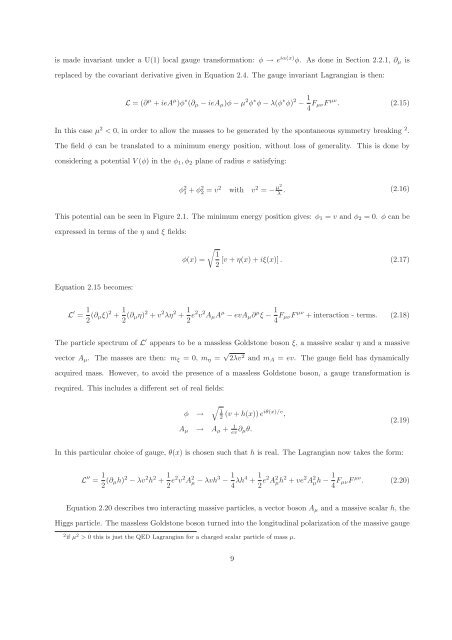CERN-THESIS-2012-153 26/07/2012 - CERN Document Server
CERN-THESIS-2012-153 26/07/2012 - CERN Document Server
CERN-THESIS-2012-153 26/07/2012 - CERN Document Server
You also want an ePaper? Increase the reach of your titles
YUMPU automatically turns print PDFs into web optimized ePapers that Google loves.
is made invariant under a U(1) local gauge transformation: φ → e iα(x) φ. As done in Section 2.2.1, ∂µ is<br />
replaced by the covariant derivative given in Equation 2.4. The gauge invariant Lagrangian is then:<br />
L = (∂ µ + ieA µ )φ ∗ (∂µ − ieAµ)φ − µ 2 φ ∗ φ − λ(φ ∗ φ) 2 − 1<br />
4 FµνF µν . (2.15)<br />
In this case µ 2 < 0, in order to allow the masses to be generated by the spontaneous symmetry breaking 2 .<br />
The field φ can be translated to a minimum energy position, without loss of generality. This is done by<br />
considering a potential V (φ) in the φ1,φ2 plane of radius v satisfying:<br />
φ 2 1 + φ 2 2 = v 2 with v 2 = − µ2<br />
λ .<br />
(2.16)<br />
This potential can be seen in Figure 2.1. The minimum energy position gives: φ1 = v and φ2 = 0. φ can be<br />
expressed in terms of the η and ξ fields:<br />
Equation 2.15 becomes:<br />
φ(x) =<br />
<br />
1<br />
[v + η(x) + iξ(x)] . (2.17)<br />
2<br />
L ′ = 1<br />
2 (∂µξ) 2 + 1<br />
2 (∂µη) 2 + v 2 λη 2 + 1<br />
2 e2 v 2 AµA µ − evAµ∂ µ ξ − 1<br />
4 FµνF µν + interaction - terms. (2.18)<br />
The particle spectrum of L ′ appears to be a massless Goldstone boson ξ, a massive scalar η and a massive<br />
vector Aµ. The masses are then: mξ = 0, mη = √ 2λv 2 and mA = ev. The gauge field has dynamically<br />
acquired mass. However, to avoid the presence of a massless Goldstone boson, a gauge transformation is<br />
required. This includes a different set of real fields:<br />
φ →<br />
1<br />
2 (v + h(x))eiθ(x)/v ,<br />
Aµ → Aµ + 1<br />
ev ∂µθ.<br />
In this particular choice of gauge, θ(x) is chosen such that h is real. The Lagrangian now takes the form:<br />
(2.19)<br />
L ′′ = 1<br />
2 (∂µh) 2 − λv 2 h 2 + 1<br />
2 e2 v 2 A 2 µ − λvh 3 − 1<br />
4 λh4 + 1<br />
2 e2 A 2 µh 2 + ve 2 A 2 µh − 1<br />
4 FµνF µν . (2.20)<br />
Equation 2.20 describes two interacting massive particles, a vector boson Aµ and a massive scalar h, the<br />
Higgs particle. The massless Goldstone boson turned into the longitudinal polarization of the massive gauge<br />
2 if µ 2 > 0 this is just the QED Lagrangian for a charged scalar particle of mass µ.<br />
9















